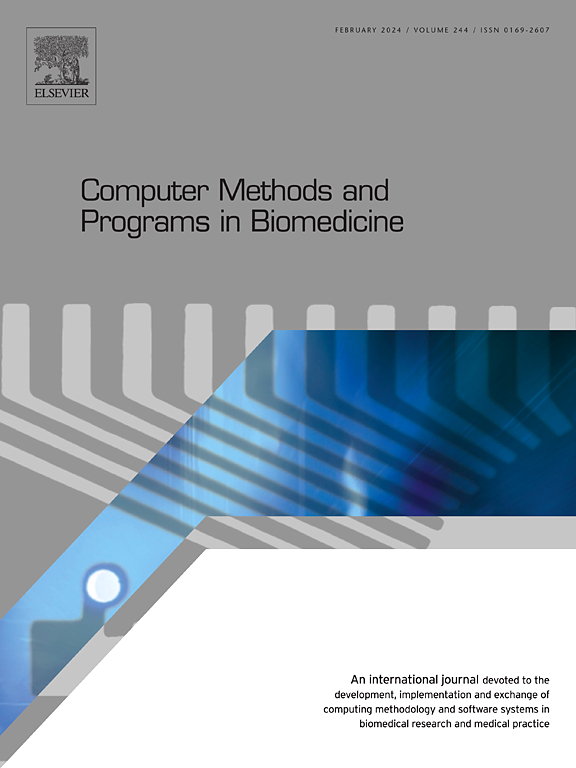MBST-Driven 4D-CBCT reconstruction: Leveraging swin transformer and masking for robust performance
IF 4.9
2区 医学
Q1 COMPUTER SCIENCE, INTERDISCIPLINARY APPLICATIONS
引用次数: 0
Abstract
Objective
This research developed an innovative Mask-based Swin Transformer network (MBST) to enhance the quality of 4D cone-beam computed tomography (4D-CBCT) reconstruction. The network is trained on 4D-CBCT reconstructed under limited scanning conditions, enabling its application to a broad range of 4D-CBCT reconstruction scenarios, including those with high scanning speeds.
Methods
4D imaging data from 20 patients with thoracic tumors were used to train and evaluate the deep learning model. 15 cases were used for training, and 5 cases were employed for simulation testing. The Feldkamp–Davis–Kress algorithm was employed to simulate 4D-CBCT from downsampled 4D-CT data to mitigate the uncertainties associated with respiratory motion between treatment fractions, and the 4D-CT data served as the ground truth for training. The study reconstructed 4D-CBCT images under 11 different scanning intervals including full angle acquisition at 1°, 2°, 3°, 4°, 5°, 6°, 12°, 18°, 24° intervals, and 1/3 full angles acquisition at 5°, 10° inrevals respectively for capturing 4D-CBCT projections. The test results were quantitatively evaluated using the structural similarity index measure (SSIM), peak signal-to-noise ratio (PSNR), mean error (ME), and mean absolute error (MAE), and image quality was qualitatively assessed. Real clinical patients who were not included in the training were tested to evaluate the network's ability to generalize. Moreover, the proposed method was compared with other deep learning approaches, and statistical analyses were performed.
Results
Simulation data assessment revealed that with small projection acquisition interval, such as the 4°interval, the 4D-CBCT images optimized by MBST showed a considerable improvement over the original 4D-CBCT images in terms of SSIM (42.3% increase) and PSNR (10.8 dB increase), and the ME and MAE values approached 0. The improvements were statistically significant (P < 0.001). Compared with other deep learning methods, MBST demonstrated superior performance with improvements of 1.4% in SSIM and 1.21 dB in PSNR and a reduction of 0.94 in MAE. With large projection intervals, such as the 24°interval, MBST outperformed other deep learning methods. Specifically, its SSIM, PSNR, and MAE increased by 3.8%, 0.81 dB, and 10.34, respectively, compared with those of other deep learning methods, and the improvements were statistically significant (P < 0.01). In addition, MBST could reconstruct bone tissue and optimize the quality of 4D-CBCT images even when the number of projections was small (12°, 18°, 24°intervals). Clinical data evaluation revealed that after optimization by MBST, the SSIM, PSNR, ME, and MAE of 4D-CBCT compared with those of 4D-CT registration improved from the original 22.8%, 15.49 dB, −345.5, and 432.2 to 81.5%, 27.93 dB, −53.79, and 73.77, respectively. Moreover, MBST exhibited the most pronounced improvement among all the compared methods. MBST could accurately recover high-density structure, lung structures, and tracheal walls.
Conclusion
This study comprehensively demonstrated the ability of MBST to reconstruct 4D-CBCT images under various scanning conditions. When the method was tested on clinical patient datasets, its CT values and image quality achieved satisfactory results. Thus, MBST can serve as a highly generalized reconstruction network for improving the quality of 4D-CBCT images.

求助全文
约1分钟内获得全文
求助全文
来源期刊

Computer methods and programs in biomedicine
工程技术-工程:生物医学
CiteScore
12.30
自引率
6.60%
发文量
601
审稿时长
135 days
期刊介绍:
To encourage the development of formal computing methods, and their application in biomedical research and medical practice, by illustration of fundamental principles in biomedical informatics research; to stimulate basic research into application software design; to report the state of research of biomedical information processing projects; to report new computer methodologies applied in biomedical areas; the eventual distribution of demonstrable software to avoid duplication of effort; to provide a forum for discussion and improvement of existing software; to optimize contact between national organizations and regional user groups by promoting an international exchange of information on formal methods, standards and software in biomedicine.
Computer Methods and Programs in Biomedicine covers computing methodology and software systems derived from computing science for implementation in all aspects of biomedical research and medical practice. It is designed to serve: biochemists; biologists; geneticists; immunologists; neuroscientists; pharmacologists; toxicologists; clinicians; epidemiologists; psychiatrists; psychologists; cardiologists; chemists; (radio)physicists; computer scientists; programmers and systems analysts; biomedical, clinical, electrical and other engineers; teachers of medical informatics and users of educational software.
 求助内容:
求助内容: 应助结果提醒方式:
应助结果提醒方式:


